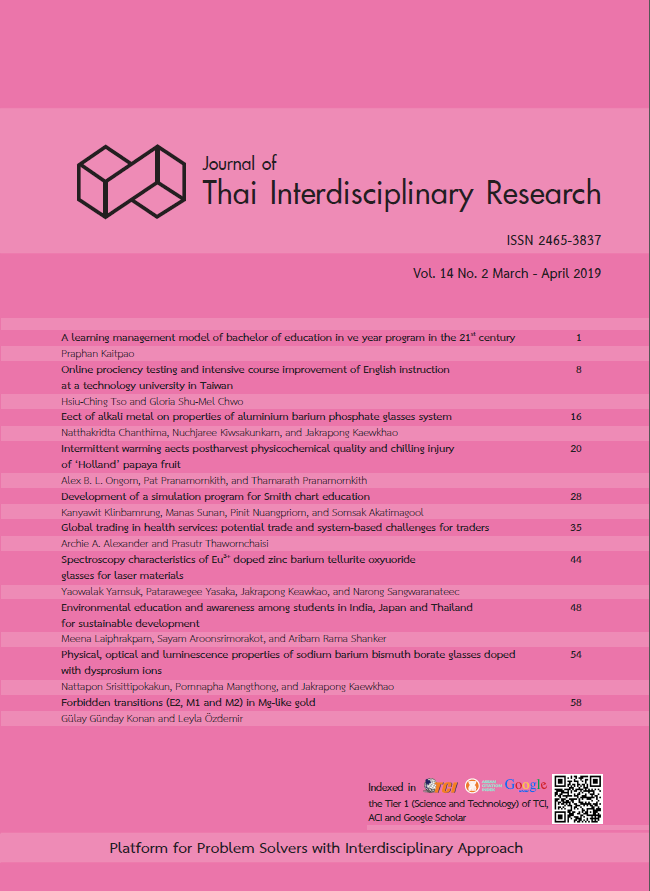Environmental education and awareness among students in India, Japan and Thailand for sustainable development
Main Article Content
Abstract
Introduction: Societies throughout the world establish educational systems in order to develop students, the future citizens, to behave in ways following the norms of the society so that we can all have a better world. Environmental education is one key which is important for the development of environmental knowledge in students. Sustainability is its main aim in order to shape human behavior, so as to improve the environment in a number of ways. Methods: The article is based on the review of literatures available from various sources, both printed and electronic. Objectives: The article aims to establish the background and importance of environmental education for sustainability. It also aims to review the various environmental education practices or strategies adopted at present in the education system of dierent countries. The countries included in this article were India, Japan and Thailand. Finally the review aims to discover the drawbacks in the environmental education in these countries. Results and Discussion: Environmental education has existed in the countries that were studied since the remote past and was rooted in their ancient tradition for the preservation of nature. When environmental education is included in the curriculum, students are expected to become increasingly aware of environmental issues, learn to take care of the environment and acquire skills and motivation to lessen current environmental problems. It was found that integration of environmental education into the school curriculum in India and Thailand is lacking behind in terms of available resources and techniques of education when compared to Japan. Conclusion: The article concluded that environmental education heightens awareness among students, which brings behavioral changes and practice, thereby leading them towards environmental protection for sustainable development.
Article Details
References
J. Douglas, Building Adaptations, 2nd edition, Oxford:Butterworth Heinemann (2006).
M. Sivamoorthy, R. Nalini, C. Satheesh Kumar, Environmental awareness and practices among college students, International Journal of Humanities and Social Science Invention 2 (2013),11–15.
A. Hassan, N. Abd Rahman, S. A. Sharifah Intan Sharina, S.Abdullah, The level of environmental knowledge, awareness,attitudes and practices among UKM students, UniversitiKebangsaan Malaysia. Retrieved on August 12, 2016 fromhttp://tree.utm.my/wp-content/uploads/2013/03/the-level-of-environmental-knowledge-awareness-attitudes-and-practices-among-ukm-students.pdf.
UN. Informal thematic debate: Climate change as a global challenge, United Nations General Assembly, 61st session, 2007, 3July – 1 August.
E. E. Smith, S. Perks, A perceptual study of the impact of green practice implementation on the business functions, Retrieved on August 15, 2016 from www.unisa.ac.za/contents/faculties/servicedept/docs/perceptual143chap1.pdf
G. Anbalagan, K. Shanthi, A study on environmental awarenessand related practices among the high school students at Maduraidistrict, Tamil Nadu, Indian Streams Research Journal 5 (2015).
R. W. Kates, T. M. Parris, A. A. Leiserowitz, What is sustain-able development? goals, indicators, values, and practice, Environment: Science and Policy for Sustainable Development 47(2005), 8–21.
Y. O. Ercoskun, Imar Planlari Yerine Surdurulebilir Kent Planlari, Gazi Universitesi Fen Bilimleri Enstitusu 18 (2005) 529–544.
UNESCO, Tbilisi Declaration, Environmental EducationFramework: Creating an Environment to Educate about the Environment, The UNEP-International Environment TechnologyCentre (IETC). Retrieved on August 15, 2016 from www.unep.or.jp/ietc/focus/ee-frame.doc
SoEnd, Learning for Life: A National Strategy for Environment Education in Scotland Edinburgh, HMSO, 1993.
H. Huckle, Education for sustainability: Assessing pathways to the future, Australian Journal of Environmental Education 7(1991) 43 – 59.
J. Fien, Trainer T. Education for sustainability, In Environmental education: A pathway to sustainability, Edited by J. Fien Geelong, Victoria: Deakin University Press, 1993.
UNESCO-UNEP, Population: Working for an equitable, sustainable development in harmony with the environment, Connect. 19(4) (1994) 1–2.
L. Yingchao, F. Masahiko, P. Wang, Study on comparison of citizens’ environmental awareness among four cities in China and Japan, Management Science and Engineering 5 (2011)126–131.
W. B. Stapp, The concept of environmental education, The Journal of Environmental Education 1 (1969) 30–31.
L. Pande, Environmental education in India: A critical assessment of development to date and suggestion for the future, Almora: Uttarakh and Environmental Education Centre (2000).
R. Alexander, Environmental Education for sustainable development in selected schools of Puducherry and Cuddalore regions, India, Ph.D. thesis submitted to Department of Ecology and Environmental Sciences, Pondicherry University, India(2012).
P. Posch, Approaches to values in environmental education inOECD/ENSI, in: Values in Environmental Education Confer-ence report (Dundee, Scottish Consultative Council on the Curriculum) (1993) 27–35.
T. Z. Siddiqui, A. Khan, Environment education: An Indian perspective, Research Journal of Chemical Sciences 5 (2015)1–6.
P. J. Dillon, C. G. Gayford, A psychometric approach to investigating the environmental beliefs, intentions and behaviours of preservice teachers, Environmental Education Research 3(1997) 283–297.
A. Uitto, K. Juuti, J. Lavonen, V. Meisalo, Students’ interest in biology and their out-of-school experiences, Journal of Bio-logical Education 40 (2006) 124–129.
O. Magntorn, G. Hellden, Reading new environments: Stu-dents’ ability to generalize their understanding between different ecosystems, International Journal of Science Education 29(2007) 67–100.
S. Nundy, The fieldwork effect: the role and impact of field-work in the upper primary school, International research in Environmental Education 8 (1999) 190–198.
Japanese Society of Environmental Education (JSOEE), Goals of Environmental Education in Japan, Retrieved on June 2016 from www.jsoee.jp/oldver/english/index.html
S. Pudin, K. Tagi, A. Periasamy, Environmental education in Malaysia and Japan: A comparative assessment, Retrieved on June 10, 2016 from http://www.ceeindia.org/esf/download/paper20.pdf
K. Amemiya, D. Macer, Environmental education and environmental behaviour in Japanese students, Eubios Journal of Asian and International Bioethics 9 (1999) 109–115.
A. Yamada, Environmental consciousness in Japan: From the survey of attitudes toward the environment, NHK Broadcasting Studies, Retrieved from https://www.nhk.or.jp/bunken/english/reports/archives/200903index.html
K. Thathong, A study of suitable environmental education process for Thai schools context. Khon Kaen University, 2010,Retrieved from www.aabri.com/manuscripts/09378.pdf
K. Thathong, Environmental ethic and environmental education, J. Education Faculty of Education (2005). (Thai)
K. Thathong, Environmental Education in Thailand: Reproduction and Reformation, in: The international Best of Both Worlds Conference, 1998.
I. Ajzen, M. Fishbein, Understanding attitudes and predicting social behavior. New Jersey: Prentice-Hall, 1980.
UNESCO. Environmental Education in the Light of the Tbilisi Conference. Paris: UNESCO, 1980.


